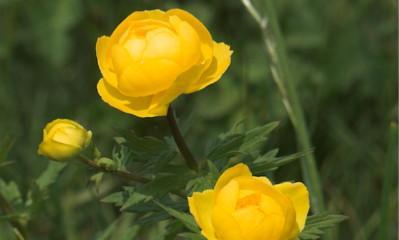- The symbol of this region is the so called “Rose of Kłodzko” a plant with yellow flowers.

- The symbol of this region is the so called “Rose of Kłodzko” a plant with yellow flowers.
- It is the local name of globeflower, which blossoms in the second half of May with spherical yellow flowers. Covering meadows in great number it catches the attention not just because of its golden colouration but also the gentle swaying in the wind. It is impossible to remain indifferent to it, which is confirmed by the frequency with which it is mentioned by the local inhabitants.
- Can it be seen on every meadow?
- Globeflower is especially prominent in damp meadows. For instance, it can be seen in Karłów in a meadow at the foothill of Great Szczeliniec. Depending on the soil fertility and humidity each meadow displays different, characteristic collections of species. Among the meadows in Stołowe Mountains, the ones regarded as least degraded and half-natural are species-rich swampy meadows containing abundant populations of certain protected plants. There are few meadows in the Park but about 40% of the Park’s flora grows on them.
- What other meadows can be found in Stołowe Mountains National Park?
- Apart from meadows rich in species there are also poorer ones, characterised by the dominance of grasses (common bent, creeping soft grass or tufted hairgrass). Meadows developed on post-agricultural soils rarely feature the protected Turkish marsh gladiolus and a sub-alpine species with broad egg-shaped leaves – Munk's rhubarb.
- Which meadows in the park are the most valuable?
- The Sudeten orchid meadow is regarded as such a habitat. It developed on fertile soil but less humid than the ones where globeflower can be seen. It contains the most species to be found here, such as orchids: eggleaf twayblade, fragrant orchid, early purple orchid and, found in only one locality in Sudetes after World War II, globe orchid. Other plant species under protections include: common columbine, round-headed rampion, fringed gentian, Bohemian early gentian and Carpathian gentian.

